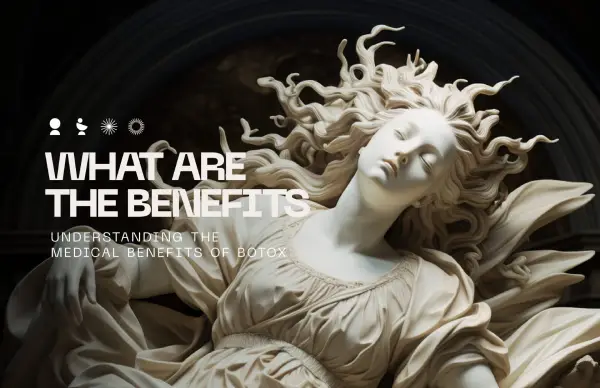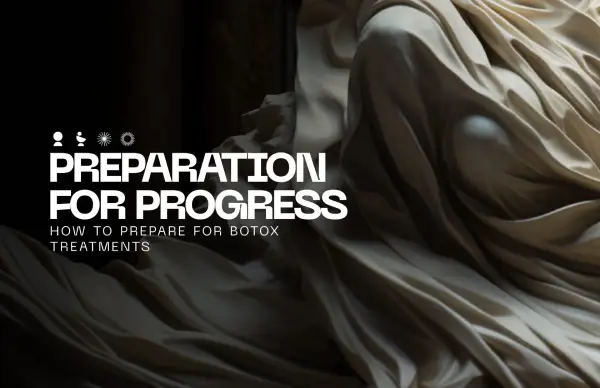Blog
Botox – why we all need it

Contents
What is Botox?
How does Botox work?
Botox uses
Medical benefits of Botox
Botox myths debunked
Is Botox safe?
How to prepare for Botox treatments
Botox aftercare
Frequently asked questions
The importance of choosing a Botox specialist
Have you ever considered the benefits of Botox treatments? This affordable procedure is simple, fast, non-invasive, and effective. It’s also said to offer a myriad of cosmetic and medical uses.
We explore what Botox is, how it works, its uses, and safety concerns. We also debunk the myths surrounding it and explain how to get optimal results.
What is Botox?
Botox, made from botulinum toxin, is a treatment that helps with anti-aging and skin rejuvenation. It may reduce wrinkles when injected in small doses. Regular sessions could reverse the signs of aging by impeding its progress.
Studies show Botox offers cosmetic and therapeutic benefits. Healthcare providers use it to treat various medical conditions. Some treatments are approved by the Food and Drug Administration (FDA).
How does Botox work?
Your nerves produce chemicals that cause muscle cells to shorten. The repetitive contractions lead to wrinkles.
Botox binds to neurons, disrupting the signaling processes that trigger muscle contraction. It paralyzes the muscles and smooths fine lines by preventing chemical release.
You should see results within 1–4 days after a Botox procedure. The effects last for about 3–4 months. We recommend regular injections for at least a year to lengthen and maximize the results.
Botox uses
Botox injections, like certain forms of peptide therapy, may reduce wrinkles. They could also treat the following skin concerns:
- Wrinkles between the eyebrows, called frown lines, elevens, or glabella lines.
- Creases around the eyes, also known as crow’s feet.
- Horizontal forehead lines.
- Wrinkles at the corners of the mouth.
- Skin “cobblestone” lesions on the chin.
Other areas where Botox injections may smooth wrinkles and fine lines include:
- Nose
- Neck
- Jawline
- Lips
Practitioners typically use Botox to treat wrinkles. Interestingly, it’s also suitable for several medical issues. Most therapies focus on conditions affecting the neuromuscular system.
The FDA approves Botox for the following health issues:
- Upper limb spasticity in those aged two years and older.
- Crossed eyes (strabismus) in patients older than 12 years.
- Excessive underarm sweating (hyperhidrosis).
- Migraine headaches that last about four hours for at least 15 days per month.
- Dystonia-related eyelid spasms (blepharospasm).
- Overactive bladder symptoms stemming from a neurological condition.
- Cervical dystonia, a neurological disorder that affects the head and causes neck pain.
People also use Botox for unapproved treatments, such as:
- Hair loss (alopecia). A disease that affects your scalp or entire body and can be temporary or permanent.
- Excessive drooling (sialorrhea) or hypersalivation. This issue is prevalent in kids with neurological disorders.
- Psoriasis. An autoimmune disease that causes rashes and itchy skin.
- Dyshidrotic eczema. A disease that causes blisters on the soles of the feet and palms of the hands.
- Postherpetic neuralgia. A chronic form of pain.
- Raynaud phenomenon. When extremities become numb and cold due to stress and low temperatures.
Medical benefits of Botox
Botox does more than reduce wrinkles. There are reported medical benefits of Botox for various health conditions.
Pain management
Botox injections may provide pain relief by blocking nerve signals affecting muscle activity. The neurotoxin potentially treats:
- Back, joint, neck, jaw, and pelvic pain
- Nerve and sciatica pain
- Neuropathy (peripheral neuropathy)
- Chronic myofascial pain (CMP)
- Osteoarthritis
Anxiety
A 2021 study found Botox may benefit people with anxiety. Those injected with Botox had anxiousness less frequently than those undergoing other treatments.
More research is necessary to learn how Botox alleviates anxiety. Additional trials will help determine the ideal injection spot and dose.
Migraines
Due to the potential benefits of Botox for migraines, the FDA has approved it for treatment. The neurotoxin is said to block the pain-signaling chemicals in the affected area.
Botox treatments generally produce better outcomes with progressive injections. Most patients notice improved results after two to three sessions.
Overactive bladder
Botox therapy is FDA-approved for overactive bladders. This condition makes you feel like you constantly have to go to the toilet. Many can’t get to the bathroom fast enough, causing them to have incontinence or wet themselves.
Botox injections relax the bladder, allowing it to fill up before triggering the urge to go. The treatment may also restore continence and provide relief.
Stomach problems
Botox may help people with difficulty moving food from their stomach to their intestines. The injections relax the pyloric sphincter muscle, allowing substances to pass.
According to research, the treatment also benefits esophageal cancer patients after surgery.
Botox myths debunked
Botox was once the subject of curiosity and misconception. Today, more facts are available. People share their experiences on social media, spreading the word about its effectiveness and benefits.
Let’s explore some debunked myths about Botox below.
Myth #1: Botox isn’t safe
All therapies have potential concerns. Botox is safe when done by a skilled practitioner. Ensure you follow the provided instructions before and after treatment carefully.
Myth #2: Botox causes your face to freeze and makes you appear expressionless
An experienced injector administers the Botox amount according to your desired outcome. It’s possible to have a more natural look with the use of lower units.
Myth #3: Botox isn’t suitable for young people
Anyone aged 18 and older can undergo Botox treatments. Botox improves elasticity and helps prevent wrinkles from developing.
Myth #4: Botox is only a treatment for wrinkles
Botulinum toxin has many reported therapeutic uses. It could help with various health issues, including chronic migraines and excessive sweating.
Myth #5: Your wrinkles will get worse after discontinuing Botox
Stopping Botox treatments won’t lead to more wrinkles. The fine lines reappear as your muscles contract. They worsen due to aging and a lack of preventative measures.
Myth #6: Botox treatments are painful
Botox procedures are minimally invasive and involve injections with tiny needles, causing almost no pain. There are methods to ease the discomfort that some patients may feel.
Is Botox safe?
Research shows that Botox treatments are mostly safe, effective, and complication-free. Some possible side effects include:
- Dry or watery eyes
- Abdominal pain
- Flu-like symptoms or headaches
- Infection, bruising, mild soreness, or swelling at the injection spot
- Droopy eyelids
Steer clear of Botox injections if you’re allergic or sensitive to the medication. Patients with an infection at the treatment site should avoid therapy until it heals.
According to research, some factors may prevent the side effects of Botox, including:
- The Botox provider’s knowledge of muscle anatomy
- Proper product storage
- Correct dose selection
- Appropriate administration methods
How to prepare for Botox treatments
Preparation helps you avoid complications that might arise from your Botox treatment.
Give your Botox provider a list of your supplements and medications. Nonsteroidal anti-inflammatory drugs (NSAIDs) and blood thinners increase bruising risk at the injection spot.
Refrain from drinking alcohol 24 hours before your treatment. Otherwise, it may cause redness and soreness.
Botox aftercare
Botox aftercare is vital for achieving optimal results and minimizing bruising. Although recovery time isn’t necessary, we recommend these Botox aftercare instructions:
- Avoid exercise for at least 24 hours. The raised blood circulation might spread the medication away from the injection site. This reduces its effectiveness and may cause bruising.
- Exercise your face by smiling, frowning, and raising your eyebrows. These motions speed up the Botox effects.
- Don’t rub, touch, or apply pressure to the injection area. These actions may move the toxin away from the treatment site.
- Sit up for four hours after the procedure to avoid dispersing the toxin. Movements like bending or lying down could also lead to bruising.
- Go without makeup for a day. Rubbing the skin when applying cosmetics may spread the toxin.
- Consult your doctor about resuming blood-thinning medications.
Frequently asked questions
The following answers to commonly asked questions offer more information about Botox treatments.
Is Botox expensive?
Botox is affordable. The exact cost depends on the number of injections and the provider’s level of expertise. Prices also vary from one location to another.
Can I combine Botox with cosmetics?
We recommend you avoid cosmetics after a Botox treatment for at least a day. You may spread the toxin when you rub the skin while putting on makeup.
How fast can I see results?
It’s possible to see results within 1–4 days of receiving Botox injections. Your provider will explain what to expect from the procedure.
Do I need follow-up treatments?
Consider regular injections for a year to maximize the effects and extend results.
How many Botox injections do I need?
The number and frequency of Botox injections depend on the treatment and your goals.
Is Botox harmful to pregnant women?
We recommend commencing Botox treatment after giving birth.
The importance of choosing a Botox specialist
The benefits of Botox are undeniable. This treatment is safe, effective, and affordable. It’s minimally invasive and suitable for reducing wrinkles and improving elasticity. Botox is also shown to ease pain, anxiety, migraines, and stomach and bladder problems.
Choosing a Botox specialist is vital. At LIVV Natural, experienced professionals offer advice and therapies that meet your goals. They advise you of pre- and post-treatment precautions to ensure a smooth procedure.
Ready to achieve a smooth, youthful appearance? Book an aesthetic consultation with us to discover the benefits of Botox.
Author: Dr. Jason Phan NMD – Founder of LIVV Natural – Anti-aging – regenerative medicine – peptide therapy


